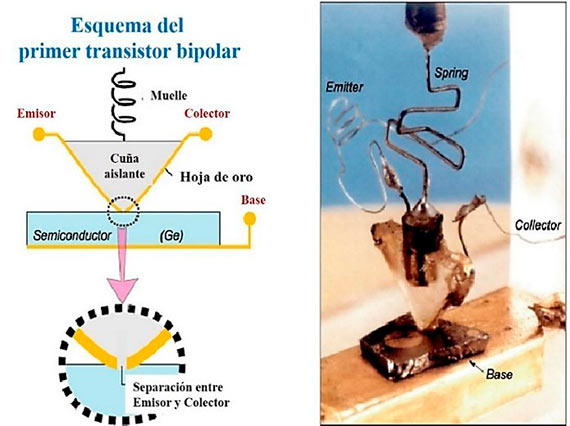The perfect tandem
In previous articles I described the biography of two of the creators of the transistor, William Shockley and John Bardeen, a device whose invention is now 70 years old in 2017. Walter Houser Brattain was the third member of the team at Bell Telephone Laboratories who succeeded in creating the first transistor in history, and while Shockley and Bardeen are relatively unknown, Brattain is even more so. The team formed by the three scientists was an almost perfect conjunction of different skills, all essential for the success of a project of this type: the experimental genius of Brattain, the technical rigor of Bardeen and the visionary daring of Shockley, the group leader.

Brattain was born in 1902 in Amoy (China), where his father was a professor of science, although shortly after in 1903 the family returned to the United States. In 1920 he began his university studies in physics at Whitman College in Walla Walla (Washington State, USA). He went on to obtain his doctorate from the University of Minnesota, after which he left the university in 1928 and joined the National Bureau of Standards (NBS). Shortly after, in 1929, he started work at Bell Telephone Laboratories, where he spent practically all his professional life, first in New York City and later in Murray Hill, New Jersey.
The birth of the transistor
In 1945 he joined the group headed by William B. Shockley and after almost two years of fruitless work –the details of which I described in the two articles mentioned above–, on December 16, 1947, they finally succeeded in making a transistor work for the first time in history. Brattain was the experimental scientist in the team, specializing in the properties of semiconductor surfaces, a field to which he and Bardeen made significant contributions. However it was Bardeen who realized why the first transistors failed to work, because the electrons remained blocked on the surface of the semiconductor supporting the device and prevented the whole transistor from working.
The team’s progress at Bell Labs was recorded in Brattain’s laboratory notebook, a genuine treasure in which he meticulously noted down all the advances and key details of the workings of the transistor. The image below shows two pages of this notebook, dated December 19 and 24, 1947, at one of the critical junctures for the success of the invention:

It was Brattain with his skill and imagination who was responsible for building the first point-contact transistor. In order to work correctly it needed to have two terminals, called an emitter and a collector, which had to be placed very close together and in contact with the surface of the semiconductor that served as a support, called the base, which was made of germanium. To make this device, Brattain stuck a strip of gold paper on the corner of a triangular wedge made of plastic, an insulating material. With a razor blade, he carefully trimmed the gold on one of the corners of the triangle so the ends were separated only by the width of a human hair (about 50 µm). The triangle with the gold threads attached to its sides was then placed on top of a germanium semiconductor piece, and the surface of the whole device was pressed down with a spring. This assembly worked as the first amplifier built with semiconductors in history. The illustration shows a diagram of the device, which was authentically homemade:

A triumph of teamwork
In spite of the limitations of the transistor created by Bardeen and Brattain, the first transistor manufactured industrially by Bell Labs was the point-contact transistor, in a variation designed in 1948 by another scientist at Bell Labs, William G. Pfann (1917-1982). It appears as patent US 2577803 of December 29, 1948, with a very similar arrangement of transistor components to the one shown in the figure above. The device was used for about ten years in the telephone systems marketed by Bell Telephone.
Brattain’s contributions to this invention, of which he was the material inventor, earned him the Nobel prize for physics in 1956 along with Bardeen and Shockley. Brattain was probably the least brilliant of the three laureates in the Bell team, something he admitted in his acceptance speech, which begins with the following paragraph:
“First let me say that while I am very proud to be one of the recipients of the Nobel Award in Physics, I am nevertheless well aware that I am only a representative of many others, without whose work and effort I would not be here today”.
Walter H. Brattain, Nobel Lecture
Unlike Bardeen (who went to the University of Illinois in 1951) and Shockley (who left Bell Labs in 1955 to found his own company), Brattain continued working at Bell Labs until his official retirement in 1967. From that time on and until his full retirement, he returned to Whitman College (where he had undertaken his physics studies), where he worked as an associate professor between 1972 and 1976, when he finally retired for good. A victim of Alzheimer’s disease, he spent the last five years of his life in a senior citizens’ home in Seattle (Washington State, U.S.A.), where he died on October 13, 1987.
Ignacio Mártil.
Professor of Electronics at Universidad Complutense, Madrid and member of the Spanish Royal Physics Society
Comments on this publication